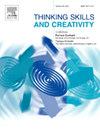Larger space does not promote divergent thinking, impair convergent thinking or defocus attention in physical and virtual environments
IF 4.5
2区 教育学
Q1 Social Sciences
引用次数: 0
Abstract
Prior research has suggested that larger spaces might enhance creative performance in divergent thinking tasks. To further investigate this spatial effect and elucidate the underlying mechanism, the current study used a controlled manipulation of space size. We aimed at replicating the influence of space size on divergent and convergent thinking, while also examining defocused attention as a potential underlying mechanism through the Auditory Stroop Task. In Experiment 1, participants performed the Alternate Uses Task, Remote Association Task, and Auditory Stroop Task in both large and small physical spaces. Results indicated no significant differences in task performance across spatial conditions, with Bayesian analyses strongly supporting the null hypothesis. Experiment 2 employed a virtual reality environment, presenting participants with large and small virtual rooms where they completed the same three cognitive tasks using a virtual reality headset. Findings demonstrated higher novelty scores in divergent thinking in the smaller (vs. larger) virtual space, but no significant differences in other tasks. Bayesian analyses again favored the null hypothesis. Overall, the findings of the two experiments suggest that space size, whether manipulated in the physical or virtual environment, does not influence divergent thinking, convergent thinking, or defocused attention. The implications of these findings on embodied metaphor and defocused attention accounts are discussed.
在物理和虚拟环境中,更大的空间不会促进发散性思维,损害收敛性思维或分散注意力
先前的研究表明,更大的空间可能会提高发散性思维任务中的创造性表现。为了进一步研究这种空间效应并阐明其潜在机制,本研究采用了对空间大小的控制。我们的目的是复制空间大小对发散性和收敛性思维的影响,同时也通过听觉Stroop任务检查分散注意力作为潜在的潜在机制。在实验1中,被试分别在大空间和小空间中进行交替使用任务、远程关联任务和听觉Stroop任务。结果表明,在不同的空间条件下,任务表现没有显著差异,贝叶斯分析强烈支持原假设。实验二采用了虚拟现实环境,向参与者展示了大小不同的虚拟房间,在那里他们使用虚拟现实耳机完成了同样的三个认知任务。研究结果显示,在较小(相对较大)的虚拟空间中,发散思维的新颖性得分更高,但在其他任务中没有显著差异。贝叶斯分析再次倾向于零假设。总的来说,这两个实验的结果表明,无论是在物理环境还是虚拟环境中进行操作,空间大小都不会影响发散思维、收敛思维或分散注意力。本文还讨论了这些发现对具身隐喻和注意力分散理论的启示。
本文章由计算机程序翻译,如有差异,请以英文原文为准。
求助全文
约1分钟内获得全文
求助全文
来源期刊

Thinking Skills and Creativity
EDUCATION & EDUCATIONAL RESEARCH-
CiteScore
6.40
自引率
16.20%
发文量
172
审稿时长
76 days
期刊介绍:
Thinking Skills and Creativity is a new journal providing a peer-reviewed forum for communication and debate for the community of researchers interested in teaching for thinking and creativity. Papers may represent a variety of theoretical perspectives and methodological approaches and may relate to any age level in a diversity of settings: formal and informal, education and work-based.
 求助内容:
求助内容: 应助结果提醒方式:
应助结果提醒方式:


